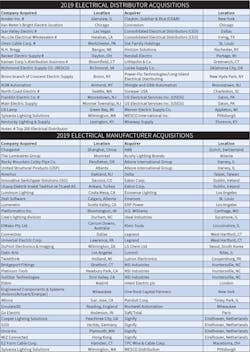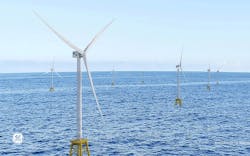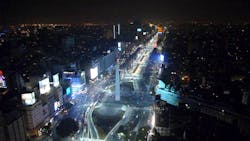2019 continued the steady pace of acquisition activity of both electrical distributors and electrical manufacturers, and that maturation of new technologies is sure to create news sales opportunities in the electrical market. On the manufacturing side, the lighting industry saw the most M&A action, with at least 13 of the 31 manufacturer acquisitions that Electrical Wholesaling magazine and Electrical Marketing newsletter reported on in 2019. And as you can see in the chart below, eight of the 2019 Top 200 electrical distributors were acquired.
There were some big-time manufacturer acquisitions, too. Add on the continuing developments in IoT, lighting controls, renewables and modular construction, and it’s been quite a year. Let’s take a deeper dive into some of the biggest trends and news that surfaced in 2019.
Lighting deals dominate electrical manufacturers’ acquisition activity
When measured by the number of deals, the control segment of the lighting industry saw the most action, but in terms of sheer size and industry impact, the acquisition of Cree’s lighting division by Ideal Industries, Sycamore, IL, and Signify’s purchase of the Cooper Lighting Solutions, Peachtree City, GA, attracted the most attention. Signify also made three smaller acquisitions, with the purchases of iLOX, Vechta, Germany, and One Inc., Plymouth, MN (two specialists in livestock lighting); and WiZ Connected, Hong Kong, a developer of WiFi-based lighting.
By any measure, Ideal’s purchase of Cree’s lighting division for approximately $310 million, and Signify’s acquisition of Cooper Lighting Solutions were the two largest deals in the lighting market. Ideal isn’t a stranger to the lighting industry, as the Audacy Advanced Wireless Lighting Control product line it launched in 2015 has been installed in several high-profile projects, including the Chicago Cubs’ Wrigley Field and the NFL Denver Broncos’ Mile High Stadium. Its acquisition of Cree still caught many industry observers by surprise.
The Cooper Lighting Solutions sale to Signify for $1.4 billion was not a surprise, as Eaton had announced its intentions to spin off its lighting business some time ago. Adding Cooper’s wide array of lighting fixtures and related lighting solutions to Signify’s already formidable package of lighting brands that Philips Lighting built up over the years through dozens of acquisitions gives Signify a commanding presence in the market. Another major lighting player may soon be changing hands, as Osram Licht AG is being courted by AMS AG, and, at press-time, was mulling over a $4.4 billion offer. Along with its core lighting business, the company also produces semiconductors for optical sensors, laser diodes and LEDs.
The lighting industry has never seen more change. If someone told you five years ago that by 2020 the former “Big Three” — GE Lighting, Sylvania and Philips — would all operate under different ownership or operating structures, and big-name players including Cree and Cooper Lighting would be sold, it would have seemed unlikely. But new LEDs, wireless lighting controls and IoT networks opened the market to new players from outside the lighting world, and they have been able to compete with and, at times, overtake traditional players saddled with converting their legacy lighting focus to the new world of LEDs. The turmoil will continue in lighting and you can expect to see more acquisitions soon of companies with specialties in human-centric lighting, horticulture, IoT-enabled lighting controls and wireless technology.
NSi makes three notable acquisitions
NSi, Huntersville, NC, expanded its already diverse product offering with three purchases this year: Bridgeport Fittings, Stratford, CT; Platinum Tools, Newbury Park, CA a provider of VDV (voice, data & video) hand tools; and most recently SullStar Technologies, Simi Valley, CA, a manufacturer of VDV tools and connectors. These three deals will definitely make 2019 a year to remember for NSi, as it has been relatively quiet on the acquisition front. The company did make headlines some years ago with its 2006 acquisition of Tork Inc., White Plains, NY.
With its long history in the fittings market and decades-old relationships with independent reps and electrical distributors, the acquisition of the family-owned Bridgeport Fittings is very definitely one of the deals of the year in the electrical wholesaling industry. Bridgeport comes to NSi with more than 2,500 products and 170 patents.
Sonepar’s acquisition of North Coast Electric Supply heads up a list of Top 200 acquisitions
Sonepar North America, Paris, has been a player in the Pacific Northwest for some years through its 2002 acquisition of the Portland, OR-based Eoff Electric, but its purchase of North Coast Electric, Seattle, expands its influence in this market in a very big way through the company’s 34 branches in the region. North Coast Electric, ranked #21 in EW’s 2019 Top 200 ranking with $478.1 million in sales, will also give Sonepar expanded coverage in the industrial automation market through its Rockwell Automation relationship.
While North Coast Electric is the biggest of the Top 200 distributors to be sold this year, the other seven companies were all big players in other regions or product niches. The seven Top 200 electrical distributors that were sold in 2019 were Anixter Inc., Glenview, IL (Clayton, Dubilier & Rice); Sun Valley Electric, Las Vegas, and Nu-Lite Electrical Wholesalers, Harahan, LA (CED); Omni Cable Corp., West Chester, PA (Dot Family Holdings); Becker Electric Supply, Dayton, OH (Kendall Electric); and Franklin Electric Co., Moorestown, NJ, and Main Electric Supply, Monroe Township, NJ (U.S. Electrical Services).
Distributors, independent reps and manufacturers prepare themselves for a tighter market
Fears of an imminent recession seem to have subsided, but electrical executives can expect some tighter market conditions. As you will see in the National Factbook on page 20, some of the key leading indicators for the electrical market are pointing to slower growth in 2020. There will be local geographic pockets of strength and some market niches (educational construction and data centers come to mind) will prosper. But if you survived the Great Recession of 2007-2009, a bit of a slowdown in the business cycle next year won’t seem too bad.
A Look Ahead at Some of the Technologies That Could Reshape the Future
While this article focuses on the news and trends that have had the most impact on the electrical wholesaling industry over the past year, Electrical Wholesaling’s editors thought you might enjoy learning about several technologies that have the potential to change things over the next few years.
Modular Construction: Now Cutting Project Time in Half
EW’s editors attended seminars at two electrical industry events this year that focused on the radical cost savings now being delivered by modular construction. With the modular building concept, portions of a construction project can be pre-manufactured in a controlled environment and often with the use of automated processes or material handling equipment. It’s often used where the rooms in a building are very similar if not exactly alike, as with apartment buildings, hotels, and, in some cases, medical buildings. Wiring devices, boxes, wiring and other electrical products are preassembled in the walls, along with plumbing and HVAC products and systems. When the rooms are complete, they are delivered by truck to the construction site, and then often stacked on top of each other like Lego bricks. We have also seen examples of modular construction where just the walls are prefabricated with the electrical and mechanical systems in place, and the lifted onto the building by crane.
During a panel discussion on modular building at the 2020 Dodge Construction Forecast in Chicago, The Hill Group, Franklin Park, IL, and Skender Construction, Chicago, discussed how they utilized the concept. Skender said in a press release that for some of its upcoming apartment projects in Chicago, “multi-family housing modules will leave the factory 95% complete. Once on-site, apartment modules will be stacked together with a bolt-and-pin system and additional welding. Stone accents and brick claddings can be added to help the building blend into the specific neighborhood, bringing the project in at least 40% faster than that of a traditional model.”
And at this year’s NECA Show in Las Vegas, ABB’s eFab Group Director Colin Ross discussed modular building in his seminar, “Embracing Lean and Improving Profitability with Prefab.” Ross urged attendees to study the new competitors in the construction market that offer modular building solutions, including pre-built walls with core mechanical, electrical & plumbing (MEP) already installed. One example he gave is Menlo Park, CA-based Katerra. The company is currently building thousands of multi-family housing units in the United States using modular construction techniques and construction components pre-manufactured at its factories. A case study on the Katerra website offers details on how the company was able to construct a basic multi-unit apartment building in Las Vegas in less than 90 days, when it would take more than 140 days to build a similar structure using traditional construction processes.
To learn more about modular construction, we found the websites www.katerra.com and www.skender.com to be great resources.
Offshore Wind Farms: Finally Here in the U.S.
Several offshore wind farms have been approved along the East Coast, off of Maryland, New York, New Jersey and Virginia. Opportunities will exist for companies in the construction of the onshore staging areas that will need to be built near ports for the transport of the turbines and other equipment to the offshore farm sites.
Dominion Energy recently began construction of the two-turbine, 12 MW Coastal Virginia Offshore Wind Project off the coast of Virginia Beach, VA. According to a post at www.dailypress.com, when completed in 2020, this wind farm will provide 3,000 homes with energy. Other big news this year in the U.S. offshore wind industry were projects off the coasts of New Jersey and New York. Ørsted’s 1,100 MW Ocean Wind project off the coast of Atlantic City, NJ, will produce enough electricity to power 500,000 homes. Ørsted has quickly become a big name in the U.S. offshore wind market, and according to a recent company press release, it has a project pipeline with more than 8 GW in seven states.
And in July, the state of New York announced its approval of two large farms off the coast of Long Island, NY — Equinor’s Empire Wind and Ørsted & Eversource’s Sunrise Wind development projects. According to a press release from Governor Cuomo’s office, when complete these wind farms will produce 1,700 MW — enough to power more than 1 million homes. New York has also pledged $15 million to train workers for offshore wind jobs and develop port infrastructure, according to the same press release.
The International Brotherhood of Electrical Workers (IBEW) is watching this market closely and was involved with the first offshore wind farm in the United States — the 30 MW Block Island Wind Farm, which was commissioned in 2016. E.W. Audet & Sons Inc., a Providence, RI-based electrical contractor, and IBEW Local 99 worked on this wind farm. According to a post on www.ewaudet.com, the E.W. Audet & Sons’ crew and IBEW Local 99 workers needed specialized training to work offshore on the wind farm, including rescue training, work-at-sea training and training in climbing. Project Manager Jeff Audet said in the post that the crew worked 14-hour days, six to seven days a week. A press release on the IBEW web site said another one of its members, Aladdin Electric, Johnston, RI, worked shore-side on the project, helping to install a temporary construction facility, and that it expects Local 99 workers to be involved with other offshore wind farms in New England and New York.
LiFi: Light Waves That Carry Data Amazingly Fast
Look for an Electrical Wholesaling feature next year on how LiFi technology may one day revolutionize how the we transmit online information over the Internet. LiFi utilizes light waves to transmit data at speeds said to 100 times faster than today’s WiFi networks. See a report in the NewsWatch department (page 8) about how PureLifi, the founder of the technology, is positioning LiFi in the lighting and telecommunications world.
5G Enabled Smart Street Lights
5G networks are said to be up to 20 times faster than the 4G networks our cellular telephones currently use, but the signals don’t travel particularly far and will need to be boosted by small antennas and repeaters. Telecommunications industry analysts say that to bring this technology to cities, these antennas and repeaters will often be installed on street lights, a potential new market for electrical contractors and their suppliers. Navigant research estimates there will be 73 million web-enabled smart streetlights by 2026 and says these streetlights will be powered by 5G networks. With this technology, city planners, security personnel and maintenance crews can equip streetlights with video cameras, smoke or gas detectors and other IoT-enabled sensors to remotely monitor traffic and security incidents.
According to a Signify press release, the company recently worked with the city of Buenos Aires, Argentina to utilize the Philips CityTouch lighting management system to manage 91,000 light points in the city. “Combined with the SAP HANA platform, it has helped Buenos Aires reduce operational costs by 50% and the city has seen a major decline in CO2 emissions and given city officials a 360-degree view of data,” the release said.
Sidebar: Passing On
The electrical industry lost some industry leaders and beloved co-workers over the past year. Electrical Wholesaling sends its condolences and best wishes to the families, friends and co-workers of John Bovyer, Electrical Sales of Ohio; Ida Cohen, Meyda Tiffany; Herm Isenstein, DISC Corp.; Shirley Leviton, Leviton Manufacturing; Stan Rydzynski, Channel Marketing Group Joseph Schick, Raub Supply Co.; Ruth Rodale Spira, Lutron Electronics; and Don Wirtanen, CANTEX.
About the Author
Jim Lucy
Editor-in-Chief of Electrical Wholesaling and Electrical Marketing
Jim Lucy has been wandering through the electrical market for more than 40 years, most of the time as an editor for Electrical Wholesaling and Electrical Marketing newsletter, and as a contributing writer for EC&M magazine During that time he and the editorial team for the publications have won numerous national awards for their coverage of the electrical business. He showed an early interest in electricity, when as a youth he had an idea for a hot dog cooker. Unfortunately, the first crude prototype malfunctioned and the arc nearly blew him out of his parents' basement.
Before becoming an editor for Electrical Wholesaling and Electrical Marketing, he earned a BA degree in journalism and a MA in communications from Glassboro State College, Glassboro, NJ., which is formerly best known as the site of the 1967 summit meeting between President Lyndon Johnson and Russian Premier Aleksei Nikolayevich Kosygin, and now best known as the New Jersey state college that changed its name in 1992 to Rowan University because of a generous $100 million donation by N.J. zillionaire industrialist Henry Rowan. Jim is a Brooklyn-born Jersey Guy happily transplanted with his wife and three sons in the fertile plains of Kansas for the past 30 years.





